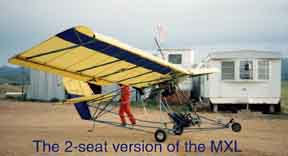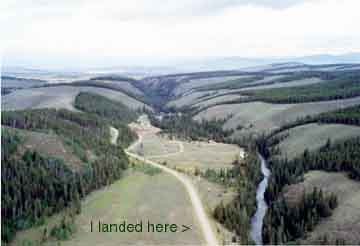The William’s Fork Valley Incident
Mistakes are simply events we wish did not happen and could have prevented. However, that does not necessarily mean that they are bad. Much good can come out of a mistake, especially if the individual making the mistake recognizes it, recovers from it without harm, and learns from it. This applies to all aspects of life, from flying to marriage.
A good example of this occurred during my United States Ultralight Association (USUA) flight test a few years back when I unknowingly looped my lap belt over the MXL flight control arm that runs along the right side of the seat. (For the uninitiated, the MXL ultralight aircraft is basically a lawn chair with wings and an engine.) It could have been a disastrous mistake, but I caught it during the flight control check before takeoff. I learned from that mistake and will probably be more attentive to pre-takeoff checks from now on.

Looking back on the flight training that Adrian gave me that Summer in Colorado, I realize that what I remember most is not what he taught me, but the mistakes I made when he wasn’t with me. (Sorry Adrian!) Of course there was the incident on my first solo cross-country when I unknowingly bumped the magneto switch with my helmet and the engine quit. But that’s another story. This story is about my first cross-country flight after Adrian certified that I was a safe pilot.
Under Adrian’s guidance I filled the main and auxiliary gas tanks on the MXL and leaned how to switch them on after takeoff. Being a crude aircraft, the process was not sophisticated. The main tank was above my head and held close to 5 gallons. The fuel gage consisted of looking at the tank, which was translucent. For cross-country, flying two auxiliary fuel tanks were placed below and behind the pilot's seat. They looked identical to the red plastic fuel containers that people use to fill their lawn mowers, except that these had an I.V. tube connecting them to the engine. In the middle of the tube was a rubber squeeze ball (primer bulb) to help start gas flowing up the tube.
It was a normal takeoff, and I climbed out to about 1000 feet above ground before switching to the left auxiliary tank. I then continued my climb west toward Cottonwood Pass, which is probably around 10,000 feet in elevation. (The airfield was at 7500 feet.) I was not gaining altitude quickly enough to cross the pass at a safe altitude, so I did a slow 360 turn, during which the engine quit. I quickly squeezed the primer bulb on the gas line for the left auxiliary tank and the engine caught before it stopped completely. I commend myself for that quick action. There were other things I also squeezed, but they didn’t help the situation.
A few minutes later, as I was crossing Cottenwood pass, the engine started to quit again, and I again squeezed the primer bulb to keep the engine running. This scenario occurred approximately 20 more times during the 40 minute flight west to the William’s Fork River and then south toward Ute Pass. Finally my left wrist began losing strength (too bad it wasn’t the right tank), and I said "...enough of this nonsense - something is not working as advertised."
Okay, so I am a bit slow. I like to think of it as persistence. In military and civil aviation, when your only engine quits once, it is considered an emergency. I'm sure 22 times is a record. In a normal aircraft with radios, declaring an emergency means calling someone. In an ultralight there is no way to declare an emergency except by yelling as loud as you can. It is useless, but it may make you feel better. Basically, you are on your own.
By this time I knew that the auxiliary tanks were not feeding properly, but I wasn’t sure what to do about it other than switch back to the main tank, which I did. I was almost at my destination anyway and needed to switch to the main tank to land. The main tank worked fine and, after buzzing the ranch where I worked, I entered downwind for a landing on County road #3. I had previously checked this stretch of the road for power lines and other obstacles, so I knew I could land there. No traffic was in sight, so I turned final and made a reasonably good landing.

At the far end of this convenient runway the road curves to the left and goes up a hill. I had no intentions of going this far. I was planning on taxiing into the ranch entrance just before the curve. County road #3 is a two-lane dirt & gravel road with the obligatory ditch on each side. As I taxied toward the ranch entrance, a pickup truck came speeding down the hill and around the curve. I didn’t see it until it was uncomfortably close. It was not dangerously close, but I was unaccustomed to seeing trucks barreling down on me while I’m in an airplane.
I instinctively did what any driver would do. I pulled over to let the truck go past. I reverted to a role of driver instead of pilot, and forgot about the wing, which reached out and grabbed a tree along the side of the road. It spun the MXL around very nicely so that the wings were parallel to the road and the nose wheel was in the ditch. It left a nice clearance for the truck to pass.
Fortunately, I was not taxiing all that fast, so the only damage was a dent in the wing leading edge tube and a bigger dent in my ego - especially with all my friends from the ranch watching. A check for $250 fixed the former, but the latter remains a permanent part of my psyche. After clearing the wreckage off of the highway and allowing my adrenaline level to go down, I determined that the plane was flyable (don’t ask) and took off in the other direction. About half way through the takeoff roll a car appeared and was heading toward me. I had learned my lesson well and pressed on. The driver pulled over and waved as I flew over him.
The flight home was uneventful as flights go. The air was getting bumpy, I did have to go to the bathroom, and I kept having nagging doubts about the MXL’s airworthiness, which were not helped by frequent glances at the dent in the leading edge. However, the engine did not quit once, which by now was in and of itself cause for celebration. (I used the main tank all the way back.) Later Adrian admitted that he forgot to tell me about opening the air valve on the auxiliary tanks so the gas would feed through the tubing. I have since purchased an ice pick to use on either Adrian or the auxiliary tanks as the need arises.
A number of mistakes were made, and I don’t put all of them in the good category, although time does tend to give events a positive glow–as in "the good old days." I did learn more on that flight than any other. But they were things that can’t be learned well in any other way. I do know that I am a better pilot because of that flight - so the net result must be good. On the other hand, if I had it to do over again, I’d rather have it happen to Adrian.